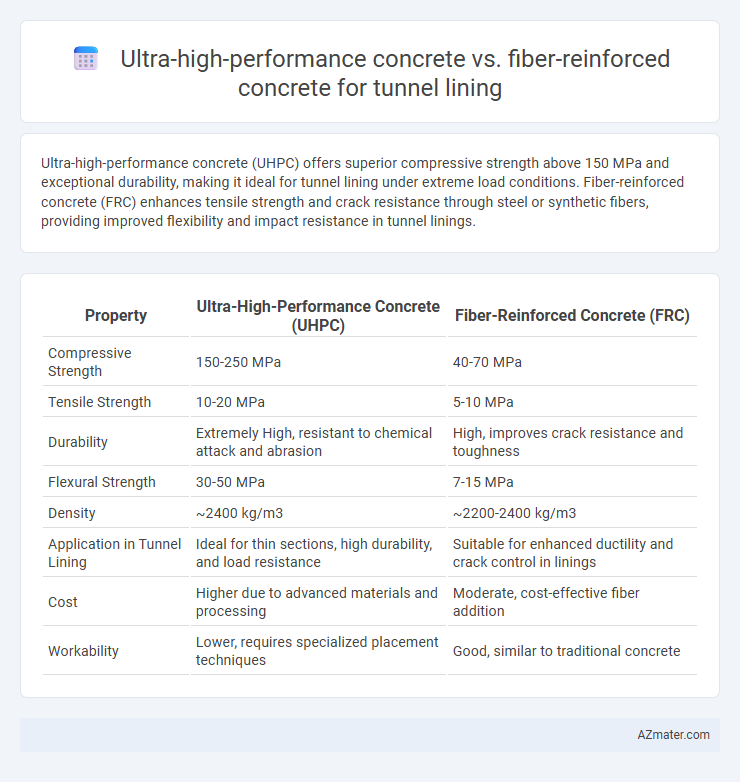Ultra-high-performance concrete (UHPC) offers superior compressive strength above 150 MPa and exceptional durability, making it ideal for tunnel lining under extreme load conditions. Fiber-reinforced concrete (FRC) enhances tensile strength and crack resistance through steel or synthetic fibers, providing improved flexibility and impact resistance in tunnel linings.
Table of Comparison
| Property | Ultra-High-Performance Concrete (UHPC) | Fiber-Reinforced Concrete (FRC) |
|---|---|---|
| Compressive Strength | 150-250 MPa | 40-70 MPa |
| Tensile Strength | 10-20 MPa | 5-10 MPa |
| Durability | Extremely High, resistant to chemical attack and abrasion | High, improves crack resistance and toughness |
| Flexural Strength | 30-50 MPa | 7-15 MPa |
| Density | ~2400 kg/m3 | ~2200-2400 kg/m3 |
| Application in Tunnel Lining | Ideal for thin sections, high durability, and load resistance | Suitable for enhanced ductility and crack control in linings |
| Cost | Higher due to advanced materials and processing | Moderate, cost-effective fiber addition |
| Workability | Lower, requires specialized placement techniques | Good, similar to traditional concrete |
Introduction to Tunnel Lining Materials
Ultra-high-performance concrete (UHPC) and fiber-reinforced concrete (FRC) represent advanced materials increasingly utilized for tunnel lining due to their exceptional mechanical properties and durability. UHPC offers superior compressive strength exceeding 150 MPa and remarkable resistance to abrasion and chemical attack, making it ideal for high-stress environments. FRC enhances toughness and crack resistance through dispersed fibers, improving deformation capacity and durability under dynamic loading conditions commonly encountered in tunnel structures.
Defining Ultra-high-performance Concrete (UHPC)
Ultra-high-performance concrete (UHPC) is a densely packed, cementitious composite characterized by a compressive strength exceeding 150 MPa and enhanced durability due to optimized particle packing and low porosity. It incorporates fine powders, low water-to-cement ratios, and often steel or synthetic fibers to achieve superior mechanical properties and resistance to chemical attack. In tunnel lining applications, UHPC offers exceptional load-bearing capacity and long-term performance compared to conventional fiber-reinforced concrete.
Overview of Fiber-reinforced Concrete (FRC)
Fiber-reinforced concrete (FRC) incorporates discrete fibers such as steel, glass, or synthetic materials to enhance tensile strength, toughness, and crack resistance in tunnel lining applications. The fibers improve durability and energy absorption under dynamic loads, reducing the risk of brittle failure and extending the service life of underground structures. Compared to ultra-high-performance concrete, FRC offers a more flexible and cost-effective solution while maintaining sufficient mechanical properties for safe and resilient tunnel linings.
Mechanical Properties Comparison: UHPC vs FRC
Ultra-high-performance concrete (UHPC) exhibits superior compressive strength exceeding 150 MPa, significantly outperforming fiber-reinforced concrete (FRC), which typically ranges between 40-80 MPa. UHPC also demonstrates enhanced tensile strength and modulus of elasticity due to its ultra-dense matrix and optimized fiber distribution, providing improved durability and resistance to cracking in tunnel linings. In contrast, FRC offers better energy absorption and ductility through dispersed fibers, making it more effective in controlling crack propagation under dynamic loading conditions.
Durability and Longevity in Tunnel Applications
Ultra-high-performance concrete (UHPC) offers superior durability and longevity for tunnel linings due to its ultra-low permeability, high compressive strength exceeding 150 MPa, and exceptional resistance to chemical attack and abrasion. Fiber-reinforced concrete (FRC) enhances toughness and crack control through dispersed steel or synthetic fibers, improving fatigue resistance and reducing micro-cracking but typically features lower compressive strength and durability compared to UHPC. The choice between UHPC and FRC for tunnel lining depends on project-specific durability requirements, exposure conditions, and lifecycle performance expectations.
Flexural and Impact Resistance Analysis
Ultra-high-performance concrete (UHPC) exhibits superior flexural strength and impact resistance compared to fiber-reinforced concrete (FRC) in tunnel lining applications, with flexural strength values often exceeding 25 MPa and impact toughness improvements up to 50%. The dense microstructure of UHPC contributes to enhanced durability and crack control, significantly outperforming FRC, which relies on fiber distribution for load transfer and crack bridging. UHPC's high compressive strength above 150 MPa and improved energy absorption capacity make it ideal for critical tunnel linings subjected to dynamic and impact loads.
Construction and Installation Efficiency
Ultra-high-performance concrete (UHPC) offers superior strength and durability, enabling thinner tunnel linings that significantly reduce formwork and excavation time during construction. Fiber-reinforced concrete (FRC) enhances crack resistance and ductility but generally requires thicker sections, potentially increasing material volume and installation duration. The rapid setting time and self-consolidating properties of UHPC lead to faster placement and reduced labor costs, improving overall construction and installation efficiency in tunnel lining projects.
Cost-effectiveness and Lifecycle Assessment
Ultra-high-performance concrete (UHPC) offers superior durability and compressive strength compared to fiber-reinforced concrete (FRC), resulting in reduced maintenance costs and extended service life for tunnel linings. Despite UHPC's higher initial material cost, its enhanced resistance to cracking and environmental degradation leads to lower lifecycle costs over the tunnel's operational period. Lifecycle assessment reveals that UHPC's longer durability and lower repair frequency make it more cost-effective for long-term tunnel infrastructure investments than conventional FRC options.
Sustainability and Environmental Impact
Ultra-high-performance concrete (UHPC) offers superior durability and strength, significantly reducing maintenance frequency and resource consumption in tunnel lining applications, which enhances sustainability through extended service life and lower lifecycle emissions. Fiber-reinforced concrete (FRC) improves crack resistance and ductility, enabling thinner linings that reduce material usage and waste, thus offering an environmentally friendly alternative by minimizing raw material demands and associated carbon footprints. Selecting UHPC or FRC for tunnel lining depends on balancing durability benefits against material efficiency to optimize long-term environmental impact and sustainability goals.
Optimal Material Selection for Tunnel Lining
Ultra-high-performance concrete (UHPC) offers exceptional compressive strength exceeding 150 MPa and superior durability, making it ideal for tunnel lining exposed to high mechanical loads and aggressive environments. Fiber-reinforced concrete (FRC) enhances crack resistance and ductility through embedded steel or synthetic fibers, providing improved toughness and energy absorption in seismic or impact-prone tunnels. Optimal material selection for tunnel lining depends on balancing UHPC's robustness and longevity with FRC's flexibility and crack control, tailored to specific geological conditions and structural requirements.

Infographic: Ultra-high-performance concrete vs Fiber-reinforced concrete for Tunnel lining
 azmater.com
azmater.com